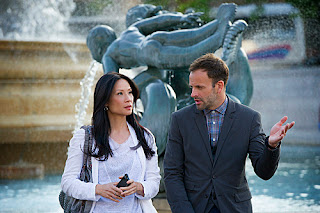Elementary, I love
thee. How do I count the ways?
Mostly by criticizing your every move and overthinking your
various plots, because that is how I show my affection. I’m from New England.
If we love you, we give you crap. If we hate you, we give you crap. But if we
don’t give you crap, that’s how you know it’s really bad: we don’t even
remember you exist.
As a side note, it’s October now and I’ve been really
missing New England and all the fall gorgeousness, as well as the joy of
snarking at leaf-peepers and the fun of finally getting to wear all my
sweaters. I miss home. And watching Elementary
tromp around New York, while not exactly the same as home (Boston, ftw!), is
still enough to make me nostalgic.
So, with no further unnecessary bits, let’s talk about the Elementary season two premiere. Partly
because I just finished rewatching all of season one, and partly because it’s
fall and that’s what we do in fall. I might be a bit punchy right now. It’s
been a bit of a week.
And it’s only Tuesday.
Anyway. For those of you who don’t know, Elementary is yet another modern update
of the Sherlock Holmes stories by Arthur Conan Doyle, who must be genuinely
upset about how much attention his least favorite character still garners. As
opposed to BBC’s Sherlock, however, Elementary is perfectly happy to mess
with the source material, as evidenced by the basic changes they’ve made to the
structure. It’s a one-hour procedural with serialized elements that airs on
CBS, it takes place in New York, and oh yeah, Watson is a woman. Also
Asian-American. Because of reasons.
These basic changes do quite a lot to change the show
around, and do strongly manage to rise above being gimmicks. Sherlock’s reasons
for being in New York make quite a lot of sense (left London in disgrace when
his drug problem got bad enough, ended up in New York before bottoming out and
going to rehab), as does his relationship with Dr. Joan Watson (she’s his sober
companion turned detective partner). All in all, it’s a fantastic adaptation
and well worth looking into.
Oh, and Elementary’s
Moriarty is my favorite thing in the history of ever. For the record.
So. Elementary is
back, and roughly in the same shape in which we left it. Joan (Lucy Liu) is
still consulting with Sherlock (Johnny Lee Miller), and though we didn’t get to
see a lot of their status quo in the premiere episode, it seems reasonable to
believe that their relationship continues much the same. Joan drags Sherlock to
AA meetings, Sherlock ditches them to go solve cases, Watson is irritatingly
perceptive, Holmes is prickly but lovable. Rinse, repeat.
This episode, however, dragged us out of our comfort zone
and swiftly off to London, where Sherlock’s old associate, DI Lestrade (Sean
Pertwee – son of the Third Doctor), has gotten himself into “a spot of
trouble”. By which we mean that Lestrade accused a rich man of murdering his
wife, then found himself driven off the force by the rich man and his army of
lawyers. Now on the lam and still convinced he’s right, an alcoholic, abusive,
angry Lestrade demands that Sherlock help him. Meanwhile, New Scotland Yard
just wants Sherlock to find Lestrade so that they can keep an eye on him.
Complicating matters, as soon as Joan and Sherlock land in
London they try to go to Sherlock’s London home, 221B Baker Street, only to
find that it has been invaded and remodeled. Expecting to find one of his
underworld contacts maintaining the place, Sherlock is shocked and displeased
to find that Mycroft (Rhys Ifans), his loathed older brother, has moved in.
Mycroft and Joan hit it off in a mutually “tell me
everything you know about Sherlock please” kind of way, while Sherlock goes off
to solve a murder. Which he does. Turns out the husband did do it, with a
plastic gun created by a 3-D printer and an associate. The associate turns up
dead, but Sherlock and Joan manage to prove that the husband really was the
killer, and all turns out well in the end.
Except for the part where a vindicated Lestrade now takes
credit for Sherlock’s work on national television, therefore giving in to his
own addiction to fame and the limelight and setting himself up for another
fall. And Mycroft and Sherlock manage to have a moment of reconciliation,
facilitated by explosives. Nice to see the boys getting along so well.
Obviously, in an episode like this, the actual murder is the
least important bit. That was well written and pretty standard fare, so no
complaints here. By and large the show is very good about their mysteries. Oh,
they’re not epic masterworks of deception and cunning, but they are
interesting, and serve as fantastic venues for the character development, the
real meat of the show, to take center stage.
So. Let’s talk about the characters then.
While there’s a part of me that appreciates Elementary giving us a glimpse of
Sherlock in his native London after so long in New York, there’s another bit
that was a little annoyed by this episode. It just felt rather unnecessary.
Sure, the plot was cool and the idea of Sherlock finding himself the one
saddled with an addict friend was a nice twist, especially as Sherlock starts
to try to make amends for his past actions. But it still felt a little stale.
I mean, Joan loves the scenery. They complain about jetlag.
Sherlock comments on the surveillance state in Britain. There’s a flat at 221B
Baker Street and some time spent at New Scotland Yard. It’s so very…Sherlock
Holmes.
I know that’s a weird complaint coming at a show that is an
adaptation of the Sherlock Holmes stories, but I think it fits. A large part of
Elementary’s success derives from its
comfort deviating from the Sherlock Holmes narrative. In the original books,
not only was Watson more of a fanboy than an assistant, and Sherlock kind of a
pompous blowhard, the detectives were all incompetent, the discoveries were all
about Sherlock, and the mysteries were all ridiculously obtuse.
That Elementary
has chosen to shift the focus onto Watson as the lynchpin of the series, as
well as depict Sherlock Holmes as more of a socially awkward man with
tendencies to inappropriate behavior than a savant conducting an orchestra of dunces
is much to the show’s credit.
I like that Elementary is set in New York. I like
that Joan Watson is first a woman and second not white. I like that he consults
for the NYPD. And I love that everyone is always calling Sherlock on his crap.
All of that is wonderful. I don’t actually need to see London and the familiar
trappings of the story to be engaged. I’m good.
That having been said, however, Rhys Ifans makes a great
Mycroft, and it was a fun episode. I don’t think the show is in trouble, exactly,
but it’s more that I want to make sure they don’t forget why we love it in the
first place. I don’t need another Sherlock Holmes who lives in London and is
emotionally unavailable. I want my Sherlock to chill out in New York, raise
bees on his roof, and give money to the homeless. I like my Sherlock. Please
don’t mess with a winning formula.
Please.







I'm very purist about Sherlock Holmes adaptations. Which of course primes me to dislike almost all of them. In a way, the fact that Elementary is *so* different makes it easier to like - it's departed far enough from the original that it's off the scale that demands it be compared to it, or to the Jeremy Brett series. Which is my way of saying that I agree it should keep up that departure.
ReplyDeleteI have to confess that I've not actually seen the Jeremy Brett one, though I hear on good authority that it's awesome.
Delete